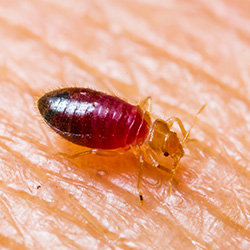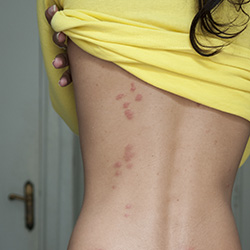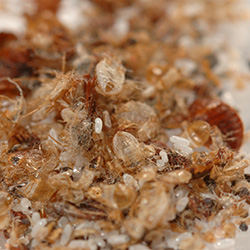
What are bedbugs?
Bedbugs are very small ranging from 1.5 to 10 mm in size. They have flat, oval bodies, are brown in colour, and have no wings. Their eggs are white and about 1 mm long which are hard to see. Bedbugs feed on the blood of people and animals, but can live without food for up to a year and a half. They often bite at night and can bite anywhere on the body. Bedbugs will turn a dark red colour and have a bloated body after feeding.
Can I get sick from bedbugs?
Although bedbugs bite, they have not been linked to the spread of disease. Bedbugs bite marks can take up to 14 days to appear. They can cause swelling, redness, and itching which can lead to skin infections. In rare cases, some people may have severe allergic reactions. Bedbug infestation can also lead to a loss of sleep, stress, anxiety, depression, and fatigue. (CDC, 2017)

How do I treat bedbug bites?
The best way to treat a bite is to avoid scratching the area, keep the skin clean, and apply antiseptic creams or lotions. If the bites are very itchy or get infected, see your health care provider.
Where are bedbugs found?
Bedbugs can be everywhere. They are found on public transportation (buses, trains, and taxis), in apartments, houses, hotels, shelters, cruise ships, etc.
How do I prevent bedbug infestation?
At home:
- Clean up clutter in your home.
- Vacuum under and around your bed regularly.
- Check any entry points on walls like pipes and wires that you share with neighbours. Seal all cracks in doors, ceilings, walls, windows, and furniture with caulking.
- Check your electrical plates and tighten with a screwdriver if they are loose. (Make sure to turn the power off first)
- Be cautious and check for bedbugs when bringing used items into your home, such as mattresses, furniture, books and clothes.
When travelling:
- Don’t bring your pillow from home with you.
- Do a complete inspection of your hotel room by checking the mattress, box spring, closet, luggage stand, and furniture when you arrive.
- Do not put your luggage on the bed or carpeting. Put it on the tile floor (e.g., bathroom) until you are done inspecting the room.
- Keep your luggage on the luggage stand, not in the drawers or under the bed.
When you get home, put your luggage on a hard surface like the garage floor while you inspect it. Wash all clothes in hot water and put in a hot dryer for 30 minutes. Once emptied, vacuum your luggage, then wash the vacuum and throw out the bag.
How and where should I look for bedbugs in my home?

Using a flashlight and something to scrape the area (e.g., old credit card cut into a triangle shape), check the following places for bedbugs, dried blood (black/ brown), or eggs (white):
- Creases and folds of mattresses and box springs, cracks in bed frames and headboards.
- Bed sheets, bedding, and pillows.
- Under and between chairs and couches, rugs and carpets.
- Between the folds of curtains.
- Wood furniture like dressers, cabinets, tables, chairs, and bookshelves.
- Around windows and door frames, along baseboards, behind electrical plates, wallpaper, and picture frames.
How do I remove bedbugs from my home?
Health Canada recommends hiring a licensed professional pest control operator to remove bedbugs. Contact the Canadian Pest Management Association or provincial pest management association to find pest control companies in your area.
If you are a tenant and have bedbugs, you should talk to your landlord. Professional pest control operators can use many treatments to remove bedbugs, such as pesticide sprays or steam/heat treatments.
You should also use physical methods to remove the bedbugs:
- Wash clothes, bed sheets, pillow cases, and curtains in hot water and put them in a hot dryer for 30 minutes.
- Large items that can’t be washed (e.g., mattresses) should be steam cleaned.
- Throw out items that can’t be washed, heated, or steam cleaned.
- Vacuum the areas where the bed bugs are using a stiff brush attachment (Do not use handheld, cloth bagged, or fabric hose vacuums).
- Put the vacuum bag in a sealed white plastic bag, throw it in a garbage bin outside, and wash the vacuum and all parts in hot water with detergent.
WARNING:
- Pest control operators or homeowners should NOT use ozone generators because they can cause respiratory problems.
- If using a pesticide: Make sure it is registered by Health Canada and has a Pest Control Product (PCP) registration number. Read the label and follow the instructions. Do not use it on people, pets, beds, baby cribs, or toys. Wear gloves, goggles and a mask when using. Do not use homemade pesticides.
What does the WECHU do about bedbugs?
Our Health Unit does not investigate bedbug complaints, as it is not a health hazard. We do provide education and resources on bedbugs.
For more information contact us at 519-258-2146 ext. 4475
References
Center for Disease Control and Prevention (CDC). (2017). Bed bugs FAQs. Retrieved from https://www.cdc.gov/bed-bugs/about/?CDC_AAref_Val=https://www.cdc.gov/parasites/bedbugs/faqs.html
Health Canada. (2015). Bedbugs- what are they? Retrieved from https://www.canada.ca/en/health-canada/services/pest-control-tips/bedbugs-what-are-they.html

